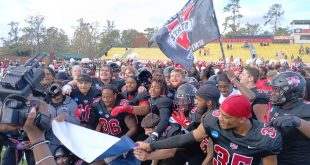Students and teachers coexist here at VSU. Professors have the job of teaching information to the best of their ability while students have the job of obtaining that information and using it in their desired field of study. But can professors’ methods of instruction affect how well students obtain the information?
Some professors have an informal teaching style while others are more formal. Informal professors will bring their personal experiences into the classrooms and stray away from the traditional lecture-styled teaching. They also tend to dress more casual with jeans and button-down shirts.
Formal professors stick to the standard lecture and uphold a professional style. These types of professors can be found dressed up more in suits and ties.
When professors come and seek a job here at VSU they must go through the Center for Excellence in Learning and Teaching.
CELT Director Dr. Jamie Landou helps offer different kinds of faculty development on different teaching topics and methods.
“Just like we teach students, faculty also has different learning styles,” Dr. Landou said. “I help them deliver their content in their particular discipline to help them learn how to deliver the information to the students.”
The teaching topics and methods that Dr. Landou presents also address different student demographics, such as first-year students, students taking online courses and students from diverse backgrounds or other high-impact practices.
Dr. Landou supports both teaching styles and is aware of how they benefit students.
“Research shows that creating a bond with your students helps them learn,” Dr. Landou said. “What you’re calling an informal teaching style can potentially help build a community within the classroom and between the professors and students.”
Marco Diaz, a sophomore criminal justice major, has many informal professors and believes they are more fun in the classroom.
“I’m more comfortable with the informal [professors] because their experiences relate to mine and they lighten up the learning environment with jokes,” Diaz said. “It doesn’t feel like you’re just learning, and their rules aren’t as strict as the other [professors].”
Dr. Thomas Hochschild, an associate professor in sociology, is an example of an informal professor. He says the way he teaches helps students stay engaged in his lessons.
“The term I use to describe my teaching is ‘applied engagement,’” he said. “What I mean by that is that it’s real important to me that students understand why the concepts, the research and the theories in sociology relate to everyday life.”
Dr. Hochschild said that he does a lot of interactive activities along with bringing social media to the classroom setting.
“It’s a way for me to meet students where they are,” Dr. Hochschild said. “I do know that social media is a way people communicate and get their information, so if I can relate sociology to students through pop culture, through the lens of media, then I think students are more likely to want to learn and apply it to their own lives.”
Dr. Paul Vincent, a geography professor, uses a mixed example of formal and informal teaching.
“I use PowerPoints to give structure so that I stay on track and cover material that I know I need to cover, but then I tend to be less formal when I’m talking to the students and bring in personal stories to make it more relatable,” he said.
Dr. Vincent said that his type of teaching puts his students more at ease, but having structure helps him to be organized.
“I think for me, especially, it’s important to be structured because if it wasn’t structured then I would just talk aimlessly about all kinds of things,” Dr. Vincent said. “There’s definitely an advantage to being structured, but I think it’s more relaxed to be able to be less formal.”
Although many students might favor informal professors, some prefer those with a more formal style.
Alondra Rodriguez, a freshman early childhood education major, said that she has had the same experiences with professors as she did in high school but likes the formal ones more.
“I like the classroom setting because I’m actually focusing on what [the professor is] saying as opposed to being more distracted if [the professor was] informal,” Rodriguez said.
Auditory, kinesthetic, visual and writing are some of the ways students choose to obtain the curriculum they’re taught. English professor Dr. Theresa Thompson is aware of that and said that some teachers forget to take that into consideration.
“Standing up there and talking, a lot of people can learn from that, but it’s really not reaching all the different ways people learn,” Dr. Thompson said. “If you don’t accommodate that then you have trouble.”
There’s nothing wrong with informal or formal teaching. It all just depends on what works best for the students and what the professor feels comfortable doing. Student-professor relationships are very important when it comes to education, and professors can tailor their teaching styles to build those relationships. When they do, everyone wins.
Written by Lenah Allen, Staff Writer. Photo courtesy of Pexels.com.
For more News, click here
 The Spectator The independent student newspaper of Valdosta State University
The Spectator The independent student newspaper of Valdosta State University






